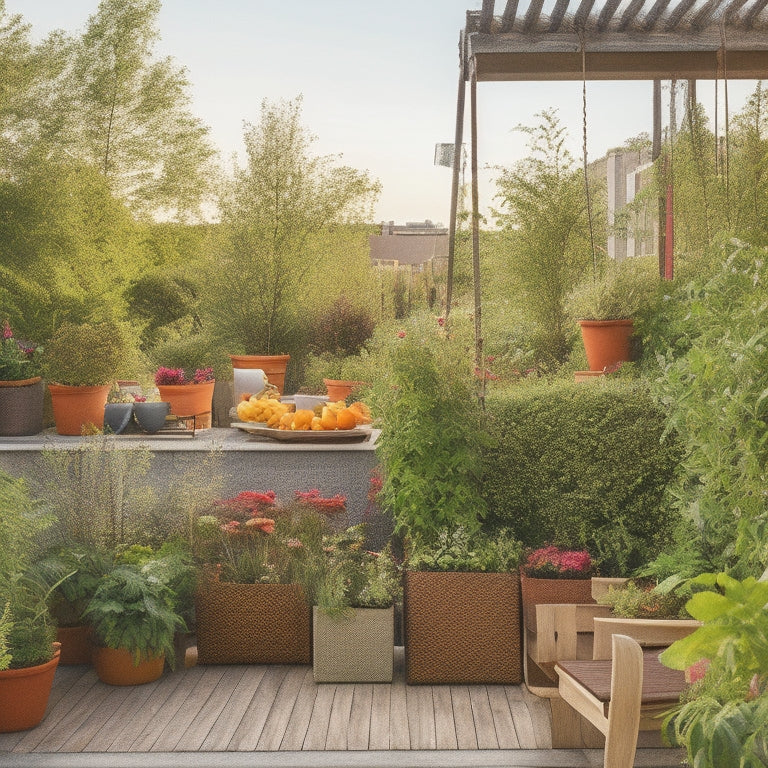
Optimize Your Rooftop Garden for Abundant Harvests
Share
You can reveal the full potential of your rooftop garden by optimizing its design and structure. Install trellises, arbors, or wall-mounted planters to triple vertical growing space and utilize unused walls effectively. Implement efficient irrigation systems, such as drip irrigation and rainwater harvesting, to reduce evaporation and runoff. Select wind-resistant plants and position them strategically to minimize damage. Choose the right crops for your climate and rotate them to maintain soil health. By following these strategies, you'll be well on your way to abundant harvests - and there's more to discover to take your rooftop garden to the next level.
Key Takeaways
• Maximize growing space with vertical gardening techniques, trellises, and wall-mounted planters to triple yield without sacrificing aesthetics.
• Implement efficient irrigation systems, such as drip irrigation and rainwater harvesting, to reduce water usage and reliance on municipal supplies.
• Select wind-resistant plants, provide wind protection, and strategically position plants to minimize damage and foster healthy growth.
• Choose the right soil depth and quality, and implement proper soil management techniques, including fertilization, mulching, and crop rotation.
• Optimize crop selection and companion planting to minimize competition, maximize yields, and create a balanced ecosystem.
Maximizing Vertical Growing Space
By installing trellises, arbors, or wall-mounted planters, you can effectively triple your rooftop garden's vertical growing space, capitalizing on often-wasted areas and boosting overall yield. This is especially essential in urban settings where space is limited.
By incorporating vertical gardening techniques, you can make the most of your rooftop's dimensions, increasing your harvest without sacrificing aesthetics. Space-saving structures like trellises and arbors provide support for vining plants, while wall-mounted planters utilize otherwise unused walls.
These structures can be customized to fit your rooftop's unique dimensions, ensuring maximum efficiency. Additionally, vertical gardening techniques can help improve air circulation, reduce soil erosion, and create a microclimate that fosters healthy plant growth.
Efficient Irrigation System Design
How can you guarantee that every drop of water counts in your rooftop garden, particularly when water conservation is crucial in urban areas?
By designing an efficient irrigation system, you'll make certain your plants receive the right amount of water at the right time. A drip irrigation system is an excellent choice, as it delivers water directly to the roots, reducing evaporation and runoff. This method also encourages healthy root growth and minimizes water waste.
To take your irrigation system to the next level, consider incorporating rainwater harvesting. Collecting and storing rainwater in a tank or cistern can greatly reduce your reliance on municipal water supplies. This approach not only conserves water but also reduces stormwater runoff and decreases your water bill.
When designing your system, make sure to include a first flush device to remove debris and contaminants from the collected rainwater. By combining drip irrigation with rainwater harvesting, you'll create a sustainable and efficient irrigation system that will help your rooftop garden thrive while minimizing its environmental impact.
Crop Selection and Rotation
When selecting crops for your rooftop garden, you'll need to take into account the compatibility of different plants to guarantee a harmonious and productive growing environment.
By choosing crops that thrive in similar conditions and have complementary growth habits, you'll minimize competition and maximize yields.
Now, let's explore the key factors to bear in mind when selecting and rotating your crops, including seasonal planting schedules and crop compatibility considerations.
Crop Compatibility Considerations
You must carefully select and rotate crops in your rooftop garden to guarantee a harmonious and productive growing environment, as incompatible plants can hinder growth and even spread disease. Incompatible plants can compete for resources, attract pests, and disrupt nutrient balance, leading to reduced yields and increased pest management challenges. To avoid these issues, consider the following crop compatibility guidelines:
| Compatible Crops | Incompatible Crops |
|---|---|
| Marigolds and Tomatoes | Fennel and Dill |
| Basil and Peppers | Onions and Beans |
| Carrots and Sage | Potatoes and Tomatoes |
Seasonal Planting Schedules
To guarantee ideal use of your rooftop garden's space and resources, design a seasonal planting schedule that rotates crops strategically to avoid depleting soil nutrients and to minimize pest and disease buildup.
This approach assures a bountiful harvest while maintaining soil health and reducing the need for pesticides and fungicides.
When planning your seasonal planting schedule, consider the following factors:
Climate considerations: Choose crops that thrive in your local climate and adjust planting dates accordingly. For example, in regions with harsh winters, plant cold-hardy crops like kale and spinach in the fall, and warm-season crops like tomatoes and peppers in the spring.
Pest management: Rotate crops from different families to break disease and pest cycles. For instance, follow a crop like tomatoes, which are prone to fungal diseases, with a crop like beans, which are less susceptible to these diseases.
Soil nutrient replenishment: Incorporate legumes, like beans and peas, which fix nitrogen in the soil, and heavy-feeding crops, like corn and squash, which deplete soil nutrients.
Soil Depth and Quality Matters
Optimizing soil depth and quality is essential in rooftop gardens, as it directly impacts the health and productivity of plants, influences water retention, and affects the overall structural integrity of the rooftop.
You'll want to guarantee your soil is deep enough to accommodate root growth, typically between 6-12 inches. Deeper soil allows for better water retention, reducing the need for frequent watering. However, it also increases the weight on your rooftop, so be sure to consult with a structural engineer to determine the maximum soil depth for your specific setup.
To improve soil quality, incorporate organic soil amendments like compost or well-rotted manure to increase nutrient availability and water-holding capacity.
Additionally, consider installing drainage solutions like French drains or permeable membranes to prevent waterlogging and root rot. These measures will help create a thriving environment for your plants, allowing them to reach their full potential.
Companion Planting Strategies
By strategically selecting and pairing plants, rooftop gardeners can create a symbiotic environment that fosters healthy growth, deters pests, and boosts yields. Companion planting is a clever approach to optimize your rooftop garden, and it's easier than you think. By combining plants with complementary characteristics, you can create a balanced ecosystem that benefits from each other's strengths.
Here are some effective companion planting strategies to try:
-
Marigolds and Tomatoes: Plant marigolds alongside tomatoes to repel nematodes, whiteflies, and other pests that target tomatoes. Marigolds' strong scent also deters aphids and other pests, making it an excellent addition to your tomato bed.
-
Basil and Peppers: Pairing basil with peppers improves their flavor and aroma while repelling pests like aphids and spider mites. Basil's fragrance also helps to mask the scent of peppers, making them less attractive to pests.
-
Nasturtiums and Cabbage: Nasturtiums' bright flowers attract beneficial insects like lacewings and hoverflies, which prey on pests that target cabbage and other Brassicas. This pairing also improves soil health and structure.
Sunlight and Shade Management
As you strategically pair plants to create a symbiotic environment, you'll also need to contemplate the rooftop garden's most valuable resource: sunlight, which can be both a blessing and a curse if not managed properly.
Sunlight angles and intensity vary throughout the day, so it's essential to assess your rooftop's exposure to determine the ideal plant placement.
Consider the direction your rooftop faces and the time of year to identify areas that receive direct sunlight and those that are shaded.
Wind Protection and Support
On rooftops, wind can become a significant obstacle to plant growth, so it's crucial to select and position plants that can withstand wind forces or provide structural support to mitigate its effects. As you design your rooftop garden, consider the impact of wind on your plants and take steps to protect them.
To create a wind-resistant garden, you can:
-
Use windbreak structures, such as trellises or screens, to block or redirect wind.
-
Incorporate plant supports, like stakes or cages, to help plants maintain their shape and structure.
-
Choose plants that are naturally resistant to wind, such as succulents or ornamental grasses, or those that can bend and flex in the wind, like willows or birches.
Frequently Asked Questions
How Often Should I Fertilize My Rooftop Garden for Optimal Growth?
You should fertilize your rooftop garden every 1-2 weeks during peak growth, using balanced, water-soluble fertilizers or slow-release formulas, adjusting application frequency based on soil type, climate, and crop requirements for ideal growth.
Can I Grow a Rooftop Garden on a Flat Roof With No Railing?
You can create a thriving rooftop garden on a flat roof with no railing by considering weight distribution, drainage, and wind resistance in your design, and selecting plants that are compact, lightweight, and adapted to rooftop conditions.
Are Rooftop Gardens Susceptible to Pests Like Mosquitoes and Rodents?
You're right to worry that rooftop gardens can attract unwanted guests like mosquitoes and rodents, but with proactive pest management and organic deterrents like citronella and copper mesh, you can create a haven that's both bountiful and bug-free.
How Do I Deal With Rooftop Garden Weight and Structural Integrity Concerns?
When planning your rooftop garden, you'll need to take into account load bearing considerations and conduct thorough structural assessments to guarantee your roof can handle the weight, so you can create a thriving oasis without compromising safety.
Can I Use Grey Water or Rainwater for My Rooftop Garden Irrigation?
"Are you really making the most of nature's freebies? You can, by using grey water or rainwater for irrigation, but first, check grey water regulations in your area and invest in a proper rainwater harvesting system."
Related Posts
-

3 Best Tool Essentials for Creative Concrete Planters
To create visually stunning and durable concrete planters, you'll need three essential tool categories. First, you'll...
-

3 Best Tool Essentials for Creative Concrete Planters
To create visually stunning and durable concrete planters, you'll need three essential tool categories. First, you'll...
-

3 Best Tool Essentials for Creative Concrete Planters
To create visually stunning and durable concrete planters, you'll need three essential tool categories. First, you'll...
-

3 Best Tool Essentials for Creative Concrete Planters
To create visually stunning and durable concrete planters, you'll need three essential tool categories. First, you'll...
-

3 Best Tool Essentials for Creative Concrete Planters
To create visually stunning and durable concrete planters, you'll need three essential tool categories. First, you'll...
-

3 Best Tool Essentials for Creative Concrete Planters
To create visually stunning and durable concrete planters, you'll need three essential tool categories. First, you'll...
-

3 Best Tool Essentials for Creative Concrete Planters
To create visually stunning and durable concrete planters, you'll need three essential tool categories. First, you'll...
-

3 Best Tool Essentials for Creative Concrete Planters
To create visually stunning and durable concrete planters, you'll need three essential tool categories. First, you'll...
-

3 Best Tool Essentials for Creative Concrete Planters
To create visually stunning and durable concrete planters, you'll need three essential tool categories. First, you'll...
-

3 Best Tool Essentials for Creative Concrete Planters
To create visually stunning and durable concrete planters, you'll need three essential tool categories. First, you'll...
-

3 Best Tool Essentials for Creative Concrete Planters
To create visually stunning and durable concrete planters, you'll need three essential tool categories. First, you'll...
-

3 Best Tool Essentials for Creative Concrete Planters
To create visually stunning and durable concrete planters, you'll need three essential tool categories. First, you'll...
-

3 Best Tool Essentials for Creative Concrete Planters
To create visually stunning and durable concrete planters, you'll need three essential tool categories. First, you'll...
-

3 Best Tool Essentials for Creative Concrete Planters
To create visually stunning and durable concrete planters, you'll need three essential tool categories. First, you'll...
-

What to Know Before Upcycling Concrete Planters
When upcycling concrete planters, you'll want to start by evaluating the planter's size, shape, and condition to guar...
-

What to Know Before Upcycling Concrete Planters
When upcycling concrete planters, you'll want to start by evaluating the planter's size, shape, and condition to guar...
-

What to Know Before Upcycling Concrete Planters
When upcycling concrete planters, you'll want to start by evaluating the planter's size, shape, and condition to guar...
-

What to Know Before Upcycling Concrete Planters
When upcycling concrete planters, you'll want to start by evaluating the planter's size, shape, and condition to guar...
-

What to Know Before Upcycling Concrete Planters
When upcycling concrete planters, you'll want to start by evaluating the planter's size, shape, and condition to guar...
-

What to Know Before Upcycling Concrete Planters
When upcycling concrete planters, you'll want to start by evaluating the planter's size, shape, and condition to guar...
-

What to Know Before Upcycling Concrete Planters
When upcycling concrete planters, you'll want to start by evaluating the planter's size, shape, and condition to guar...
-

What to Know Before Upcycling Concrete Planters
When upcycling concrete planters, you'll want to start by evaluating the planter's size, shape, and condition to guar...
-

What to Know Before Upcycling Concrete Planters
When upcycling concrete planters, you'll want to start by evaluating the planter's size, shape, and condition to guar...
-

What to Know Before Upcycling Concrete Planters
When upcycling concrete planters, you'll want to start by evaluating the planter's size, shape, and condition to guar...
-

What to Know Before Upcycling Concrete Planters
When upcycling concrete planters, you'll want to start by evaluating the planter's size, shape, and condition to guar...
-

What to Know Before Upcycling Concrete Planters
When upcycling concrete planters, you'll want to start by evaluating the planter's size, shape, and condition to guar...
-

What to Know Before Upcycling Concrete Planters
When upcycling concrete planters, you'll want to start by evaluating the planter's size, shape, and condition to guar...
-

What to Know Before Upcycling Concrete Planters
When upcycling concrete planters, you'll want to start by evaluating the planter's size, shape, and condition to guar...
-

What to Know Before Upcycling Concrete Planters
When upcycling concrete planters, you'll want to start by evaluating the planter's size, shape, and condition to guar...
-

What to Know Before Upcycling Concrete Planters
When upcycling concrete planters, you'll want to start by evaluating the planter's size, shape, and condition to guar...
-

What to Know Before Upcycling Concrete Planters
When upcycling concrete planters, you'll want to start by evaluating the planter's size, shape, and condition to guar...
-

What to Know Before Upcycling Concrete Planters
When upcycling concrete planters, you'll want to start by evaluating the planter's size, shape, and condition to guar...
-

What to Know Before Upcycling Concrete Planters
When upcycling concrete planters, you'll want to start by evaluating the planter's size, shape, and condition to guar...
-

What to Know Before Upcycling Concrete Planters
When upcycling concrete planters, you'll want to start by evaluating the planter's size, shape, and condition to guar...
-

What to Know Before Upcycling Concrete Planters
When upcycling concrete planters, you'll want to start by evaluating the planter's size, shape, and condition to guar...
-

What to Know Before Upcycling Concrete Planters
When upcycling concrete planters, you'll want to start by evaluating the planter's size, shape, and condition to guar...
-

What to Know Before Upcycling Concrete Planters
When upcycling concrete planters, you'll want to start by evaluating the planter's size, shape, and condition to guar...
-

Accurate Measuring for DIY Block Planters Made Easy
As you begin building a DIY block planter, precise measurement is essential for a sturdy structure that can support s...
-

Accurate Measuring for DIY Block Planters Made Easy
As you begin building a DIY block planter, precise measurement is essential for a sturdy structure that can support s...
-

Accurate Measuring for DIY Block Planters Made Easy
As you begin building a DIY block planter, precise measurement is essential for a sturdy structure that can support s...
-

Accurate Measuring for DIY Block Planters Made Easy
As you begin building a DIY block planter, precise measurement is essential for a sturdy structure that can support s...
-

Accurate Measuring for DIY Block Planters Made Easy
As you begin building a DIY block planter, precise measurement is essential for a sturdy structure that can support s...
-

Accurate Measuring for DIY Block Planters Made Easy
As you begin building a DIY block planter, precise measurement is essential for a sturdy structure that can support s...
-

Accurate Measuring for DIY Block Planters Made Easy
As you begin building a DIY block planter, precise measurement is essential for a sturdy structure that can support s...
-

Accurate Measuring for DIY Block Planters Made Easy
As you begin building a DIY block planter, precise measurement is essential for a sturdy structure that can support s...
-

Accurate Measuring for DIY Block Planters Made Easy
As you begin building a DIY block planter, precise measurement is essential for a sturdy structure that can support s...
-

Accurate Measuring for DIY Block Planters Made Easy
As you begin building a DIY block planter, precise measurement is essential for a sturdy structure that can support s...
-

Accurate Measuring for DIY Block Planters Made Easy
As you begin building a DIY block planter, precise measurement is essential for a sturdy structure that can support s...
-

Accurate Measuring for DIY Block Planters Made Easy
As you begin building a DIY block planter, precise measurement is essential for a sturdy structure that can support s...
-

Accurate Measuring for DIY Block Planters Made Easy
As you begin building a DIY block planter, precise measurement is essential for a sturdy structure that can support s...
-

Accurate Measuring for DIY Block Planters Made Easy
As you begin building a DIY block planter, precise measurement is essential for a sturdy structure that can support s...
-

Accurate Measuring for DIY Block Planters Made Easy
As you begin building a DIY block planter, precise measurement is essential for a sturdy structure that can support s...
-

Accurate Measuring for DIY Block Planters Made Easy
As you begin building a DIY block planter, precise measurement is essential for a sturdy structure that can support s...
-

Accurate Measuring for DIY Block Planters Made Easy
As you begin building a DIY block planter, precise measurement is essential for a sturdy structure that can support s...
-

Accurate Measuring for DIY Block Planters Made Easy
As you begin building a DIY block planter, precise measurement is essential for a sturdy structure that can support s...
-

Accurate Measuring for DIY Block Planters Made Easy
As you begin building a DIY block planter, precise measurement is essential for a sturdy structure that can support s...
-

Accurate Measuring for DIY Block Planters Made Easy
As you begin building a DIY block planter, precise measurement is essential for a sturdy structure that can support s...
-

Accurate Measuring for DIY Block Planters Made Easy
As you begin building a DIY block planter, precise measurement is essential for a sturdy structure that can support s...
-

Accurate Measuring for DIY Block Planters Made Easy
As you begin building a DIY block planter, precise measurement is essential for a sturdy structure that can support s...
-

Accurate Measuring for DIY Block Planters Made Easy
As you begin building a DIY block planter, precise measurement is essential for a sturdy structure that can support s...
-

Accurate Measuring for DIY Block Planters Made Easy
As you begin building a DIY block planter, precise measurement is essential for a sturdy structure that can support s...
-

Accurate Measuring for DIY Block Planters Made Easy
As you begin building a DIY block planter, precise measurement is essential for a sturdy structure that can support s...
-

Accurate Measuring for DIY Block Planters Made Easy
As you begin building a DIY block planter, precise measurement is essential for a sturdy structure that can support s...
-

Accurate Measuring for DIY Block Planters Made Easy
As you begin building a DIY block planter, precise measurement is essential for a sturdy structure that can support s...


